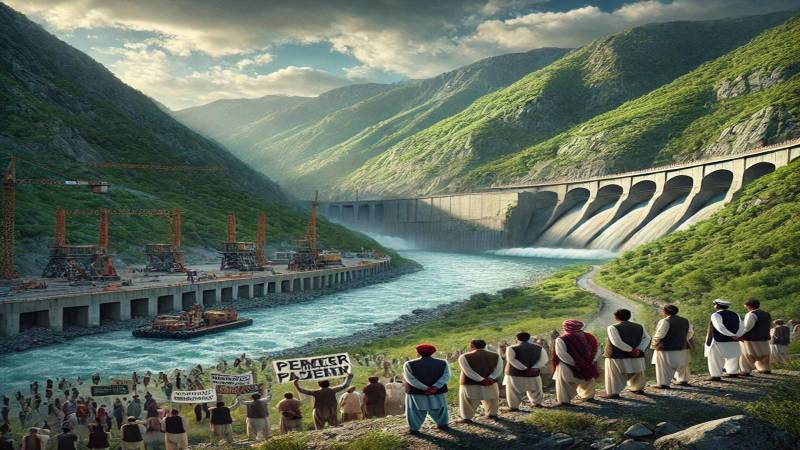
Pakhtunkhwa Energy Development Organisation (PEDO) was initially established in 1986 as a small hydel development organisation to develop small hydel projects with a capacity of up to 5MW. However, later working under various names it was finally called PEDO with the passage of the PEDO Act 2014. Pedo has since been working with the KP government for hydel power generation. It has been working on the construction of many hydropower projects in KP and for most of these projects it has been funded by international institutions, through Khyber Pakhtunkhwa Hydropower and Renewable Energy Development Program, such as ADB and World Bank.
In 2019 Daral Khwar Hydropower Project with a total installed capacity of 36MW was completed by Pedo in Bharain Town, District Swat. Pedo is now working on a couple of other hydropower projects in the same region between Matiltan and Madyan. Madyan Hydropower Power Project (MHPP) is one of these projects that Pedo has undertaken to develop on the river Swat in the Bahrain region. MHPP is a run-of-the-river project. The proposed project will divert the flow of water into tunnels at Kedam and will open it again about 12 km away in Madyan. The local populations have raised grievances regarding the project and staged protests, held press conferences, etc rejecting the construction of this project. Elders and environmental activists of the area opined that the construction of this project will destroy tourism, the environment, the ecosystem, agriculture, and the local economy.
Daral Khowar Hydro Power Project
During the protests elders of the local population said that the Pedo had already constructed the Daral Khwar Hydro Power Project in Bahrain town on Daral River, a tributary to the river Swat, and attracted many tourists to the surrounding rented houses and hotels. Plus, due to Daral, the valley’s environment was quite moderate and clean. However, the pedo diverted Daral into a tunnel drying it up in the town. Pedo and the then government promised the local population that they would construct a girls’ college, water supply scheme, and hospital among other developmental works. However, after its five-year completion, the local people have not been given any of these benefits. It was mentioned in the Pedo documents that they will plant ten trees in retaliation for a single tree that might be cut down in the construction works however not only that but even the construction debris has not yet been properly disposed of. Given the cool-handedness of the previous project, the local population no longer trusts Pedo for the benefits they think that the local population will get.
The local population says that Pedo can never be trusted as it has never fulfilled its promises in the past. Technically when a 36MW capacity project can take the whole waters of Daral how is it possible that the river Swat will not be swallowed by a 207MW capacity hydropower project?
The Design of MHPP And Grievances of the Local Community
The MHPP is designed in such a way that the river Swat will be turned into tunnels and will be opened in Kalagay near Madyan where the powerhouse shall be constructed. This is about 12 km in between Madyan and Kedam where the waters will be flowing in the tunnel. The Environmental and Social Impact Assessment (ESIA) report states that only 141 houses will be affected however there are several villages namely Ghwarejo, Ponkya, Daraloi, Shagai, Ayeen, and Mankar with a population of over 25 thousand. These villages will be directly affected since they will be facing the blasts, vibrations, and tunnel excavations. There are 25 freshwater springs for drinking and irrigating thousands of acres of agricultural land. Not only springs but houses will also get damaged. The local populations have already seen many springs dried up at the construction of Daral tunnel blasts and vibrations and they fear the same will happen to these villages’ springs.
The Pedo in its Resettlement Action Plans (RAP) reports mentions only a few houses that come under the area of direct influence however in local populations’ protests the elders, lawyers, civil society, and social workers all emphasised that the supposed project is fatal for the local economy and environment. With turning waters into the tunnels, the river will have no water, especially in the winter season when the water shrinks. There will be dirt, scraps, wastes and smells in the otherwise elegantly flowing river. The aquatic life will become nonexistent. With the shrinking of waters after their turning into the tunnel, the temperature of the valley will rise. The agricultural sector will be badly affected.
Swat valley is a major tourist attraction place visited by millions of people every year. In the area of influence that is from Kedam to Madyan, there are more than 70 commercial hotels and about 40 restaurants. Turning the river into a tunnel will leave these hotels vacant forever. The author has investigated two hotels constructed in the same year and having the same facilities namely Madina and Kuwait Continental. The Madina Hotel is opposite the roadside whereas Kuwait Continental is exposed to the river. Due to this difference, they have huge annual income differences. The ones having a river view are most of the time houseful. There are hundreds of antique, dry fruits, handicraft shops, and markets open for tourists. They are providing ample livelihood opportunities to the local population. Numbers of other tourist points will also fall with the diversion of the river.
In a meeting, the Pedo officials reiterated that not all the river waters will be turned into the tunnel, but local population representatives held that in the Daral Khwar hydropower project we were promised the same thing but today there is no water in Daral. The local population says that Pedo can never be trusted as it has never fulfilled its promises in the past. Technically when a 36MW capacity project can take the whole waters of Daral how is it possible that the river Swat will not be swallowed by a 207MW capacity hydropower project?
For this cause community leaders, activists, writers, traders, lawyers, hoteliers, farmers, investors, students, shopkeepers, and teachers have launched a movement named Daray-e-Swat Bachawo Tehreek. Last year in July as part of the Tehreek thousands of people gathered in Bahrain Bazar and staged a protest against the execution of the MHPP. The community social activists, leaders, and environmentalists stated that they are not asking for the preservation of the river's waters only but the local ecosystem, environment, and culture would also be endangered if the project was developed. They said the river has great socioeconomic importance for the local community.
This river plays a key role in the indirect spending of other local industries as well such as retail, transportation, hospitality, and entertainment. And that’s why river-based economies play a significant part in the socioeconomic development and sustenance of the local communities
Socioeconomic Role of The River Swat
Historically, populations have always flourished alongside riverbanks. Water sources have been a life-giving and sustaining place for the ancient people. From the River Nile in Egypt, the Tigris and Euphrates in Mesopotamia, Rhine in Europe to The Yangtze in China have been civilisations and fed populations for centuries. Even our Indus Valley civilisation has thrived at the bank of a river. So, in Swat too, our ancestors settled here due to the river, they lived here for centuries, and the river was there for thousands of years inasmuch as the river’s name became the name of the valley. It is also mentioned in the holy book of Hindus Rigved as Suvastu. The Torwali community has a cultural affinity with the river. It has a significant place in the folklore and poetry of the local communities as well. On the occasion of mother tongue function many culprits of the Torwali poetry mentioned Daral river and its magnificence but today there is no Daral.
River Swat is also famous for trout fishes. At the banks of it, there are fisheries. People go out for fishing, sightseeing, boating and swimming. The river is irrigating ample acres of land. Due to the river, the valley is a tourist attraction in summer. Many visit the valley just to watch the transparent waters of the river. However, turning such a treasure into tunnels is insane.
This river plays a key role in the indirect spending of other local industries as well such as retail, transportation, hospitality, and entertainment. And that’s why river-based economies play a significant part in the socioeconomic development and sustenance of the local communities. Instead of promoting tourism, agriculture, and other socioeconomic sectors in the locality, the government under the guise of power production intentions is dread set on the devastation of these communities living here for centuries.
Development or Retrogression
On the one hand, people are saying Pakistan’s industrialisation is hindered by the energy crisis, and if it was dealt with ironhandedly only a progressive Pakistan could be imagined. Poverty, inflation, and other structural evils can be rid of if we have electricity abundance as it will result in low-cost production, increased exports, and treasured foreign exchange reserves. Such features could only lead to development however while saying this forget to mention the methods being employed for the generation of electricity. The world is steadfastly pacing towards renewable energy mechanisms but here giants formulating policies always place their interests first and before national interests. Ignoring conflict of interest is a glamouring feature of our political system. We can have wind and solar energy projects quite inexpensive, efficient, and without conflicts but that perhaps doesn’t entail corruption that is why we often look out for projects that involve many people and operations making way for corruption, loot, and plunders.
The MHPP violates the Environmental and Social Framework, RAP, and ESIA 2023. It is being opposed by the local communities as rerouting the river poses serious threats to the locality’s stability. However, since it is forwarded for energy generation, no voices could be heard for the devastation of the local community. In the area of influence, the infrastructure damaged in the 2010s flash floods still pictures ruins. There is no education, healthcare, or other necessities but the government is determined to ravage the already few livelihood opportunities of these indigenous communities. The development of the projects on the local only sources of livelihood could be developed for the rest of the country, but it will be a retrogression for the people living there since time immemorial.

